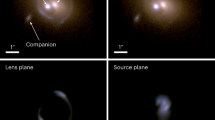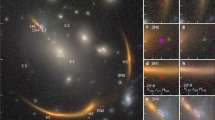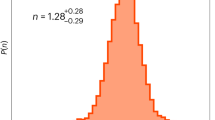Abstract
THE double quasar Q0957+561 AB is believed to be a gravitationally lensed image formed by a galaxy at redshift z = 0.36: a single quasar at z = 1.41 is seen as two images because of the intevening galaxy. I present here a measurement of the velocity dispersion of the intevening galaxy which, combined with a measurement of the time delay between the appearance of brightness variations in the two images, can be applied to a simple model of the lensing geometry to yield an estimate for the Hubble constant H0. The flux from the A and B images has been monitored for several years by two groups and a consistent value of 415 days for the time delay between variations in A and B has been obtained. The measured line-of-sight velocity dispersion for the intervening galaxy of 303±50 km s−11 then gives H0 = 50±17 km s−1 Mpc−1.
This is a preview of subscription content, access via your institution
Access options
Subscribe to this journal
Receive 51 print issues and online access
$199.00 per year
only $3.90 per issue
Buy this article
- Purchase on Springer Link
- Instant access to full article PDF
Prices may be subject to local taxes which are calculated during checkout
Similar content being viewed by others
References
Walsh, D., Carswell, R. F. & Weymann, R. J. Nature 279, 381–384 (1979).
Young, P., Gunn, J. E., Kristian, J., Oke, J. B. & Westphal, J. A. Astrophys. J. 204, 507–520 (1980).
Stockton, A. Astrophys. J. 242, L141–L144 (1980).
Gallais, P., Rouan, D., Lacombe, F. & Tiphene, D. Astr. Astrophys. 232, 16–18 (1990).
Vanderriest, C. et al. in Gravitational Lenses (ed Moran J. M., Hewitt J. N. & Lo, K. Y.) (Reidel, Dordrecht, 1989).
Schild, R. E. Astrophys. J. (submitted).
Falco, E., Gorenstein, M. & Shapiro, I. Astrophys. J. 289, L1–L4 (1986).
Falco, E., Gorenstein, M. & Shapiro, I. Astrophys. J. (in the press).
Young, P., Gunn, J. E., Kristian, J., Oke,, J. B. & Westphal, J. A. Astrophys. J. 244, 736–755 (1980).
King, I. R. Astr. J. 67, 471–485 (1962).
Unger, S. W., Brinks, E., Laing, R. A., Tritton, K. P. & Gray, P. M. La Palma User's Manual (Royal Greenwich Observatory, 1988).
Tonry, J., & Davis, M. Astr. J. 84, 1511–1523 (1979).
Danese, L., De Zotti, G. & di Tullio, G. Astr. Astrophys. 82, 322–327 (1980).
Keel, W. C. Astrophys. J. 269, 466–486 (1983).
Author information
Authors and Affiliations
Rights and permissions
About this article
Cite this article
Rhee, G. An estimate of the Hubble constant from the gravitational lensing of quasar Q0957+561. Nature 350, 211–212 (1991). https://doi.org/10.1038/350211a0
Received:
Accepted:
Issue Date:
DOI: https://doi.org/10.1038/350211a0
This article is cited by
-
The flatness problem and the pulsating universe
Il Nuovo Cimento B Series 11 (1993)
-
Parameters of the ultrastable expansive non-decelerative Universe and hypothetical mass of the electron neutrino
Astrophysics and Space Science (1992)
Comments
By submitting a comment you agree to abide by our Terms and Community Guidelines. If you find something abusive or that does not comply with our terms or guidelines please flag it as inappropriate.



